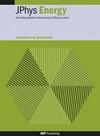Scaling considerations and optimal control for an offshore wind powered direct air capture system
IF 6.3
3区 材料科学
Q1 ENERGY & FUELS
引用次数: 0
Abstract
The optimal design and operation of an offshore wind powered direct air capture (DAC) system is complex owing to the intermittent energy supply and the modularity of the units. A solid amine DAC process involves multiple individual units which undergo periodic loading to capture carbon dioxide (CO2) from ambient air, followed by regeneration to produce pure CO2 for utilisation or sequestration. The modular nature of a solid DAC process is exploited in this study to investigate the optimal design and coordinated operation of multiple DAC units mounted on a single 15 MW offshore wind turbine platform, with battery energy storage for additional short term power buffering. Important design parameters considered include the number of independently controllable units, the cyclic capacity of each unit (proportional to the amount of adsorbent) and the battery capacity and maximum power ratings. The design study results highlighted the diminishing returns to the CO2 capture rate with scaling, with a full design optimisation based upon cost estimations left for future work as the technology matures. It was found the optimal configuration was 14 DAC units, each with a cyclic capacity of 2000 kg海上风电直接空气捕获系统的规模考虑和优化控制
由于能源供应的间歇性和装置的模块化,海上风电直接空气捕集(DAC)系统的优化设计和运行非常复杂。固态胺 DAC 工艺包括多个独立单元,这些单元定期加载以捕获环境空气中的二氧化碳 (CO2),然后进行再生以产生纯 CO2 供利用或封存。本研究利用固体 DAC 工艺的模块化特性,对安装在单个 15 兆瓦海上风力涡轮机平台上的多个 DAC 单元的优化设计和协调运行进行了研究,并利用电池储能进行额外的短期功率缓冲。考虑的重要设计参数包括独立可控单元的数量、每个单元的循环容量(与吸附剂的数量成比例)以及电池容量和最大额定功率。设计研究结果表明,随着规模的扩大,二氧化碳捕获率的收益会逐渐降低,因此,随着技术的成熟,将在成本估算的基础上对设计进行全面优化。研究发现,最佳配置为 14 个 DAC 单元,每个单元的循环能力为 2000 千克 CO2,年总捕获率为 45 600 吨/年,风能利用率为 96.6%。此外,研究还发现,基于高低负荷限制的规则控制策略与基于机器学习的控制器相比具有竞争力,并且优于模型预测控制方案。
本文章由计算机程序翻译,如有差异,请以英文原文为准。
求助全文
约1分钟内获得全文
求助全文
来源期刊

Journal of Physics-Energy
Multiple-
CiteScore
10.90
自引率
1.40%
发文量
58
期刊介绍:
The Journal of Physics-Energy is an interdisciplinary and fully open-access publication dedicated to setting the agenda for the identification and dissemination of the most exciting and significant advancements in all realms of energy-related research. Committed to the principles of open science, JPhys Energy is designed to maximize the exchange of knowledge between both established and emerging communities, thereby fostering a collaborative and inclusive environment for the advancement of energy research.
 求助内容:
求助内容: 应助结果提醒方式:
应助结果提醒方式:


